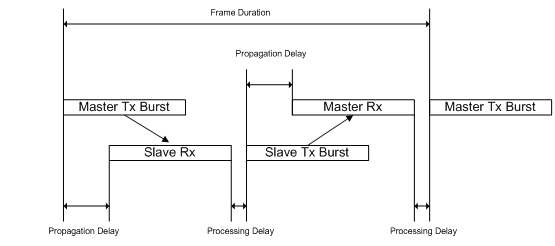TDD Overview¶
Cambium PTP unlicensed band links consist of a Master unit and a Slave unit. The links use a duplexing scheme known as Time Division Duplex (TDD). To activate TDD Synchronization, see Setting TDD Synchronization.
TDD operates by only allowing one end of the link to transmit at any one time. This allows both link directions to operate on the same radio frequency. This differs from Frequency Division Duplex (FDD), where each end can transmit and receive simultaneously but this requires the two directions to operate on different frequencies, thereby increasing the spectral requirements.
TDD operates in a cyclic fashion, with the transmissions alternating between the two ends. The cycle of events is as follows:
- Master transmits a burst
- A delay occurs as the Master burst travels over the air
- Slave receives the burst
- A delay as the Slave processes the burst
- The slave transmits a burst
- A delay as the slave burst travels over the air
- Master receives the burst
- A delay as the Master processes the burst
- Master transmits a burst
One cycle is called a Frame. The cycle period is called the Frame Duration. This is shown in Basic TDD Frame. For purposes of illustration, the delays in this diagram have been exaggerated.

Basic TDD Frame
The size of the burst depends on the configuration of TDM mode, IP mode and link symmetry.
TDM Mode¶
If the PTP link is carrying TDM traffic (E1s or T1s), it is desirable to keep the burst as short as possible in order to minimize latency. However, with shorter bursts, a greater proportion of the frame is taken up by the radio propagation delay and the burst processing delay thus reducing throughput. So, in TDM mode, the PTP link reduces the burst size as far as possible whilst still maintaining the throughput required for the configured number of E1s and T1s. The result is that burst sizes are greater for longer links.
IP Mode¶
If the PTP link is carrying IP traffic only, it is often desirable to increase throughput at the expense of latency. In IP mode therefore, the PTP link maximizes burst size. This makes the propagation delay and processing delay proportionately smaller making the frame more efficient.
Symmetry¶
The system can be configured to give more or less of the frame to a particular direction. Possible values are:
- Symmetric: Equal burst size for both link directions. Each link direction has the same maximum throughput.
- Adaptive: This mode is only available in IP mode. The size of the burst effectively adapts to the traffic being offered from the network and is independent of the size of the burst in the other link direction. As the offered traffic level increases in a given direction, the size of the burst increases in that direction in order to increase frame efficiency and therefore throughput. As the offered traffic level decreases in a given direction, so the size of the burst in that direction decreases. This allows the other link direction to take a greater proportion of the frame if required.
- 2:1 (PTP 600, PTP 650 only): Master Tx Burst is twice the size of Slave Tx Burst. Maximum throughput in the direction towards the Slave is twice the Maximum throughput in the direction towards the Master.
- 3:1 (PTP 300/500 only): Master Tx Burst is three times the size of Slave Tx Burst. Maximum throughput in the direction towards the Slave is three times the Maximum throughput in the direction towards the Master.
- 1:2 (PTP 600, PTP 650 only): Slave Tx Burst is twice the size of Master Tx Burst. Maximum throughput in the direction towards the Master is twice the Maximum throughput in the direction towards the Slave.
- 1:3 (PTP 300/500 only): Slave Tx Burst is three times the size of Master Tx Burst. Maximum throughput in the direction towards the Master is three times the Maximum throughput in the direction towards the Slave.
Summary¶
The frame duration is dependent on:
- Burst size.
- Propagation delay (link length).
- System processing delays.
The burst size is dependent on configuration:
- In TDM mode, the burst sizes are minimized as far as possible in order to reduce latency.
- In IP mode, the burst sizes are maximized in order to increase throughput. As processing delay and propagation delay are fixed (for a given link length), larger bursts are more efficient as a greater proportion of the frame is being used to carry data.